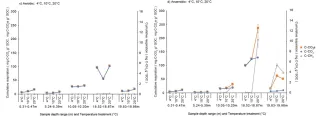Energy conducted by water can result in faster and deeper permafrost thaw.
NGEE Arctic is integrating hydro-thermal processes in models of the Arctic landscape because conduction of energy by water can result in permafrost thaw that progresses more deeply, more quickly than predicted by models representing only the slow conduction of warmer air temperatures through vegetation and soil. One large remaining uncertainty is the decomposability of deeper organic material that will also be thawed, and how different subsurface conditions control CO2 and CH4 production rates. We used a very deep sediment core (20 m) under a thermokarst lake (Goldstream Lake, Alaska), as a source of organic material to test these rates. We conducted 365-day sediment incubations under aerobic and anaerobic conditions combined with radiocarbon dating and sediment classifications. This work showed for the first time that deep Yedoma (6–15 m) and even deeper unconsolidated sediments (16–20 m) produced greenhouse gases at a higher rate (per gram carbon) than did shallow, organic-rich sediments (0–5 m). CH4 production rates were temperature sensitive, and while the timing of CH4 production was similar to previous NGEE Arctic incubations of shallower soil cores (e.g., Zheng et al., 2018), we observed that anaerobic greenhouse gas production was commensurate with aerobic production. Moreover, anaerobic greenhouse gas production had double the global warming potential due to a large contribution of CH4. Thus, the common rule of thumb that arctic carbon production from oxic environments will outpace that of anoxic environments may not hold true in deeper soil layers. Overall, we find evidence that the dynamics of deep soils should be considered in simulations of future subsurface CO2 and CH4 production.
Citation: Freitas NL, Anthony KW, Lenz J, Porras RC, Torn MS. in review. Deep permafrost thaw: A significant and overlooked source of greenhouse gas. Submitted to Nature Geoscience.
Cumulative carbon as CO2, cumulative carbon as CH4, and total carbon as CO2e, produced by day ~365 of the incubations in: (c) aerobic incubations at 4°C, 10°C, and 20°C and (d) anaerobic incubations at 4°C, 10°C, and 20°C. Each value represents an average of the analytical replicates across the final three time points (n = 9), normalized by initial quantity of soil organic carbon. Error bars show standard error.
For more information, please contact:
Margaret Torn
mstorn@lbl.gov

